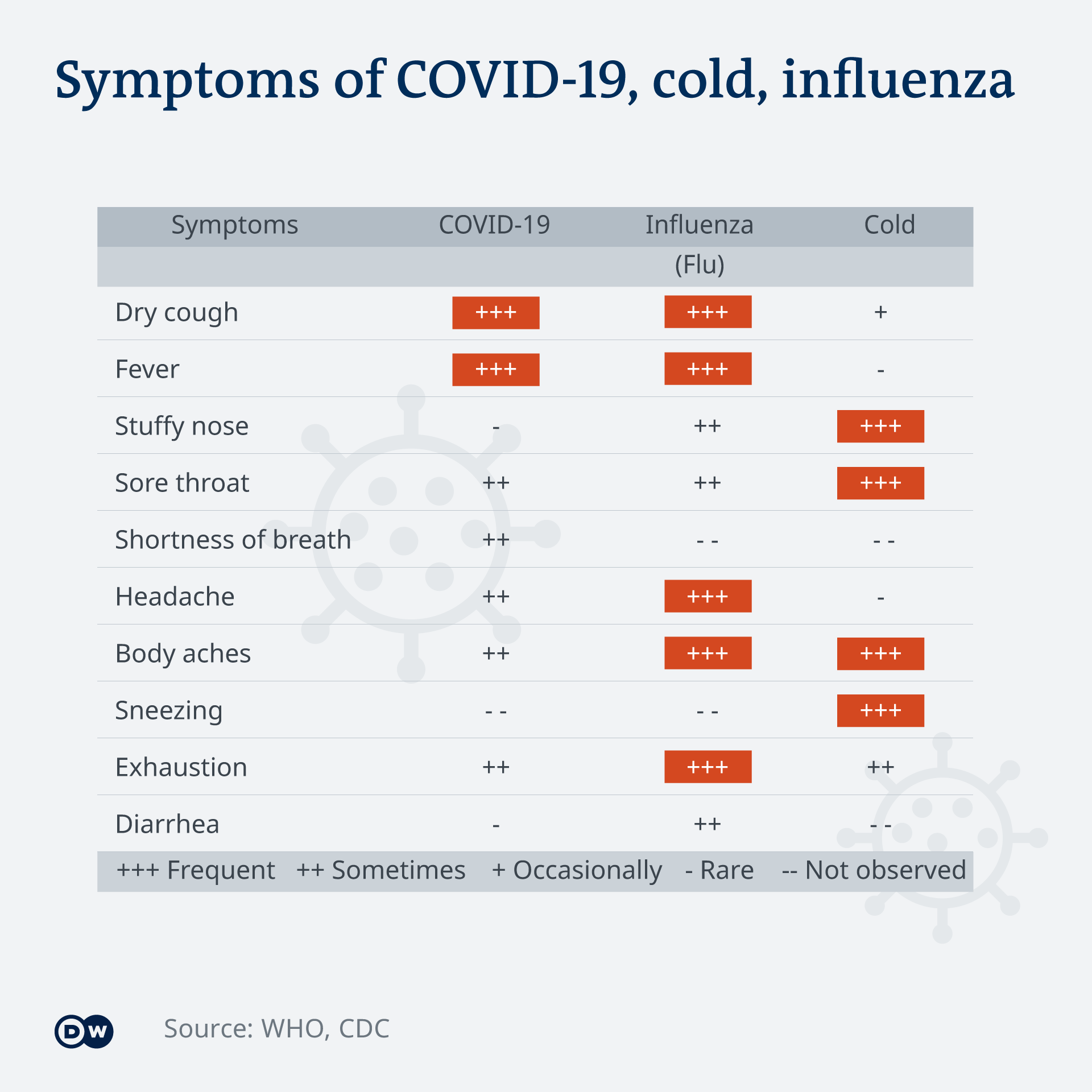As the coronavirus pandemic has progressed, more understanding of the symptoms has developed. The original guidance from the US Center for Disease Control (CDC) was that the symptoms from this coronavirus (COVID-19) are:
- sore throat
- dry cough
- fever
The World Health Organization (WHO) and the CDC later published the information in the chart at the right to help differentiate Coronavirus from the flu and the common cold.
While the sore throat, dry cough, and fever are the well known symptoms, the stories of individual cases add more nuance. A couple commonly reported early symptoms that are often overlooked are:
- loss of appetite (84% of patients)
- loss of the sense of smell or taste (50% of patients)
If someone loses their sense of smell, experts have advised to isolate for 7 days.
Several accounts have described the infection going in stages. "You'll have a cold. You'll get better. You'll get worse." If this happens, the person should see their physician.
First stage
According to people's stories, the first phase seems to start rather innocuously, and then come on "like a hurricane". Victims say that they feel a cold is coming on, reporting symptoms such as:
- Mild dry cough
- Slightly sore throat
- Really tired
This may progress to:
- Feeling pressure in the head, a migraine, pain in or around the eyes.
- Chills and fever up to 103 degrees Fahrenheit.
- Nausea
- Exhaustion
Second stage
Then energy levels may come back. The cough may lighten up. Then a next phase can begin, with:
- Sore lower back
- Swollen lymph nodes
- Heavy cough
- Shortness of breath
- Pain in the chest, like "bricks", or "an elephant standing on it"
This can then lead to viral pneumonia. The nasal congestion is not like the normal kind. You feel like you're drowning. It's imperative you then seek immediate attention. With the pneumonia comes high fever and difficulty in breathing.
Early on, patients' vitals may be unremarkable, with a normal chest X-ray. Later on, in doctors have noticed elevated white blood cell count but low lymphocyte count. There may also be lung damage, including opaque areas, and cardiomyopathy (a hardening of the heart muscle).
Coronavirus will first infect the throat, which gives the sore throat lasting 3-4 days.
The virus then blends into the nasal fluid that enters the trachea (windpipe) and then the lungs, causing pneumonia. This takes about 5-6 more days. If you have a runny nose and sputum, you have a common cold. Coronavirus pneumonia is a dry cough, typically with a fever, aches, and some nasal congestion, but no runny nose.
The new Coronavirus may not show sign of infection for many days. By the time they have fever and/or cough and go to the hospital, the lung is usually 50% Fibrosis and it's too late. Taiwan experts provide a simple self-check that we can do every morning:
Take a deep breath and hold your breath for more than 10 seconds. If you complete it successfully without coughing, without discomfort, stiffness or tightness, etc., it proves there is no Fibrosis in the lungs, basically indicates no infection. In critical time, please self-check every morning in an environment with clean air.
Emergency warning signs:
- Difficulty breathing or shortness of breath
- Persistent pain or pressure in the chest
- New confusion or inability to arouse
- Bluish lips or face
If you feel like you are having symptoms, call your doctor. If you develop emergency warning signs, get medical attention immmediately.
Treating a fever
"Taking anti-inflammatory drugs (ibuprofen, cortisone...) could be an aggravating factor of the infection. If you have a fever, take paracetamol. If you are already on anti-inflammatory drugs or in doubt, ask your doctor for advice." (French Health Minister Olivier Veran.) (1)

References:
- Stanford Hospital
- Immunologist Dr. Ahvie Herskowitz
- https://www.theeagle.com/news/national/there-s-a-lot-we-don-t-know-uw-researchers/article_4791b57c-6058-5913-85e6-4fbb72d00156.html
- https://www.the-sun.com/news/572255/39-year-old-new-orleans-woman-dies-coronavirus/
- https://www.mirror.co.uk/news/world-news/coronavirus-one-patient-italy-dying-21733027
- https://nypost.com/2020/03/13/coronavirus-survivors-may-suffer-from-reduced-lung-function/
- http://www.stationgossip.com/2020/03/22-year-old-girl-who-tested-positive.html
- https://www.cnn.com/2020/03/12/health/coronavirus-survivor-elizabeth-schneider/index.html
- https://abcnews.go.com/GMA/News/coronavirus-survivors-symptoms-presented-road-recovery-disease/story?id=69660094
- https://www.boston.com/news/health/2020/03/19/what-does-the-coronavirus-do-to-the-body
- https://www.sacbee.com/news/nation-world/national/article241095161.html
- https://www.nbcnews.com/health/health-news/slow-burn-coronavirus-symptoms-often-linger-worsening-n1164756
- https://www.npr.org/sections/goatsandsoda/2020/03/13/814691018/coronavirus-symptoms-defining-mild-moderate-and-severe
- https://www.youtube.com/watch?v=PU2ut5Ark3Q&feature=youtu.be
